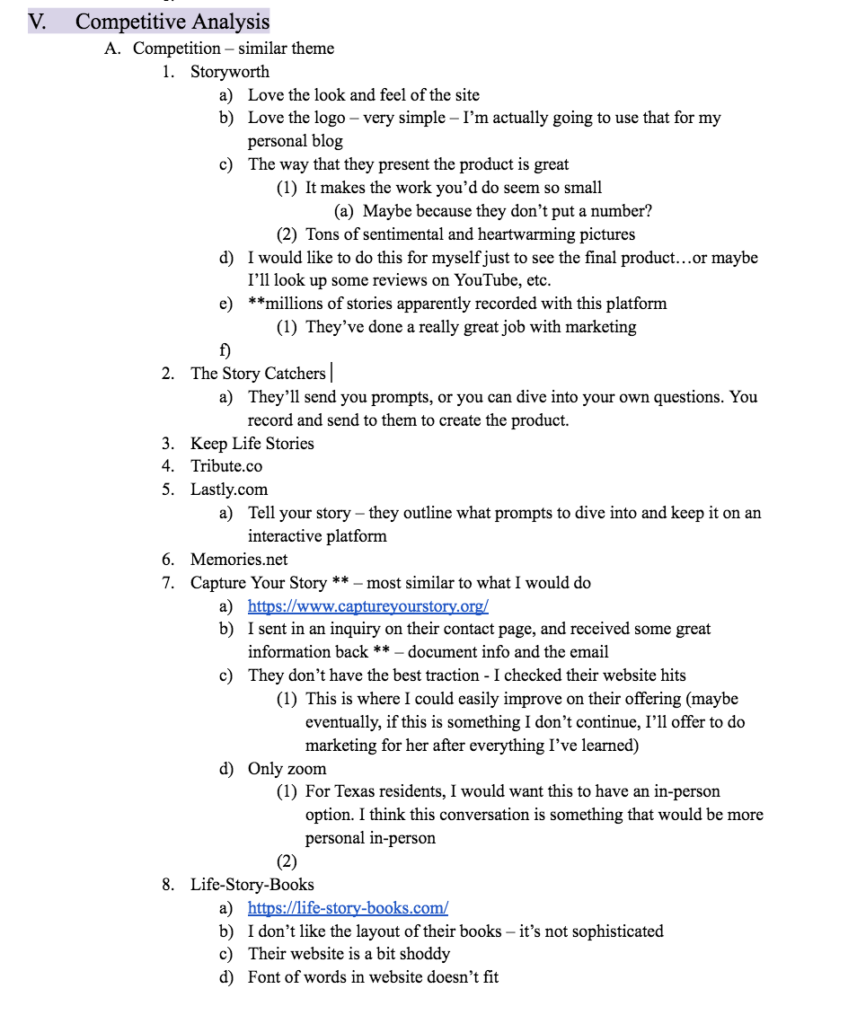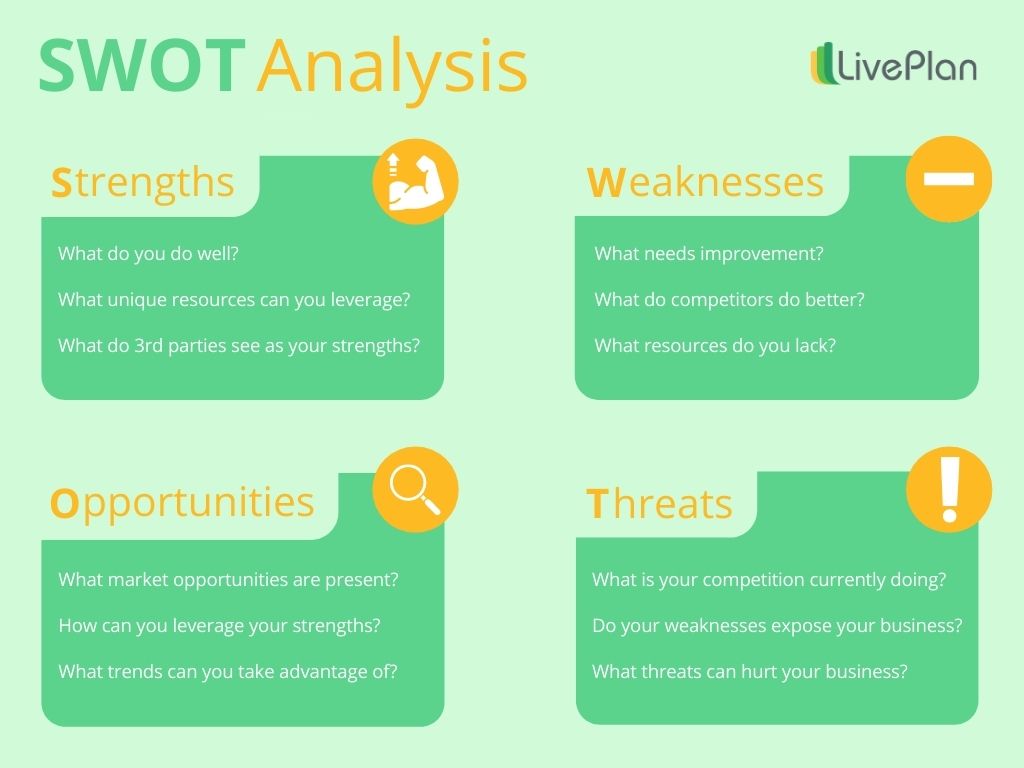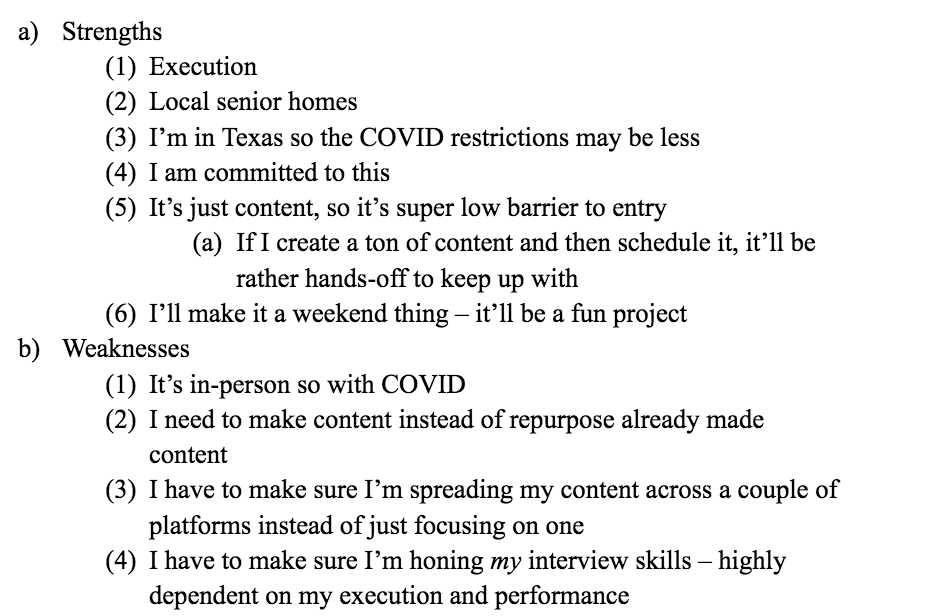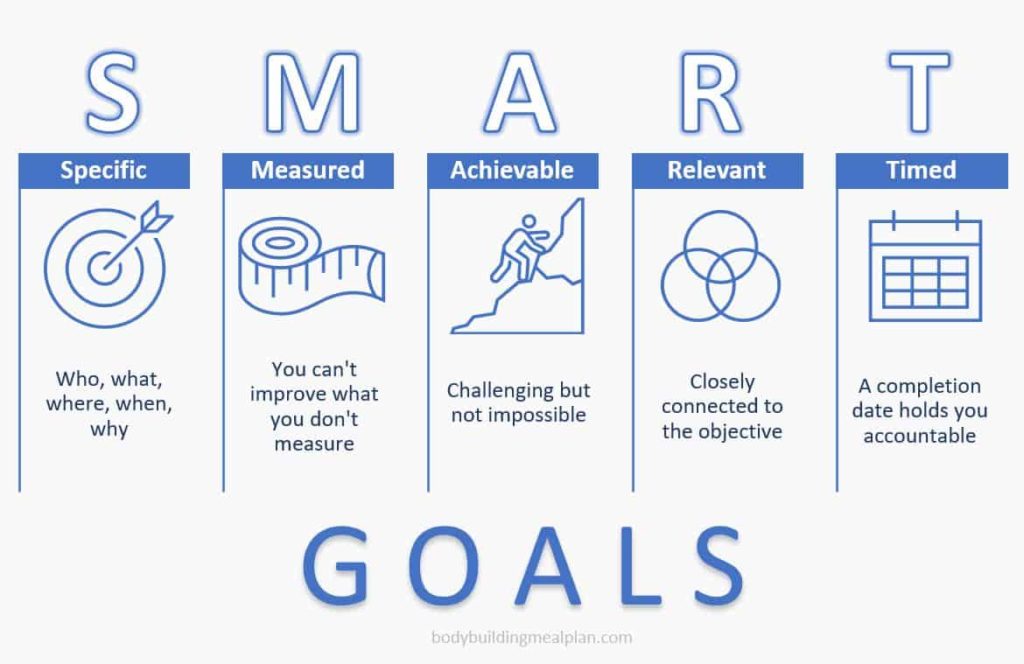“The best marketing strategy ever: CARE.”
– Gary Vaynerchuck
Everybody says that experience is the greatest educator. In the future, I want to create businesses. Thus, I decided that I might as well see how much I could learn by challenging myself to create a business in 30-days. If you’ve ever thought about doing this, and hope to live vicariously through me, you can follow my journey here and check my socials for regular updates.
What is a Marketing Plan
A marketing plan is a document to define strategies used to engage your target audience and achieve business objectives.
Everything clarified and defined in a marketing plan is leveraged as a means to the ultimate end – the success of your business.
The Basic Outline of a Marketing Plan:
- Executive Summary
- Business Description
- Comprehensive Research and Analysis
- Target Customer
- Marketing Goals and Objectives
- Success Measurements
Explanations and Examples
Executive Summary
Your executive summary is an overall summary of the full marketing plan. It serves executives who might want to read one paragraph and get the gist of your business. We’re going to come back to this after we’ve written out everything else…
Include:
- Name, location, and mission
- Highlight of major points and key conclusions
- What your product or service is, how you fit in the market, how your product differs from competitors, distribution, and relevant data
Business Description
Your business description consists of your mission statement, vision, and values. It explains the heart and spirit of your business. You can read more about constructing your business description here.
Comprehensive Research and Analysis
The objective of market research and competitor analysis is to compile information to use. As you compile, keep that in mind. You want to use this information. You’re not compiling just to compile, the result will be a directed, actionable plan.
What is a market?
Similar to an in-person market, a market is where a seller and a customer meet. Online there aren’t physical boundaries, and instead, it’s the medium, the content, and the value promised that attracts your customer. When you’re selling a similar product to someone else and competing for the same customer, often you’ll end up in the same market with similar practices. Usually, when you’re competing in a market, the key differentiators are price and quality.
Where to begin researching your market
- What is your product, and what market does it fit into? Do you need to create a new market?
- Find both Quantitative and Qualitative data
- Quantitative data – measurable, usually gathered by some sort of tool (thermometer for example); can be counted or compared numerically and factually
- Qualitative data – describes characteristics or qualities; is not measurable and cannot be factually proven (10/10 people say X does not mean that it has to be X); frequently appears in narrative form; semi-difficult to objectively analyze
- You want a mix. You want your qualitative data to back up your quantitative data and vice versa.
Using the Blue Ocean Strategy to Find Better Markets
I want to share the concept of “Blue Oceans” which has changed the way I understand competing in a market. The “ocean” or market you are a part of is either a “blue ocean,” untapped, or a “red ocean,” full of competition. More competition means that all competitors have to share, split, or win-over the same amount of customers.
You want to be in a “blue ocean” where you have relatively little competition. That sometimes means stepping outside of the things you think your brand is, to see all of the areas you could innovate. That “out of the box” thinking gives you the insight to innovate and uniquely offer value so that now, you’re not competing over quality and price, you’re offering something different.
Do the exercises recommended by the “Blue Ocean Strategy” – 6 Paths Framework – and see what insights you come up with.
Understanding Buying Decisions
The main question is: What is your product or service, and what are the circumstances that amount to someone deciding to buy.
This can be broken down into two segments:
Cognitive Biases
Cognitive Biases are the systematic patterns of deviation from rational judgement. They are the underlying psychological pulls that explain why we buy everything beyond what we need. There are cognitive biases associated with status, cognitive dissonance, superiority, gambling, and much more.
Understanding the cognitive biases that are naturally associated with your product or service allows you to be overt instead of covert.
For example: Gucci knows it appeals to the desire for status. It doesn’t pretend that it doesn’t and instead, makes that a part of its brand.
Pain Points
What are the problems that your product or service solves? Pain points are the problems and pains your customer faces. No one likes to be in pain. If you can speak to how your product or service effectively solves a problem, you can increase your conversions.
As I explained in my post about the misconceptions about marketing, you’re not trying to convince someone who doesn’t want or need your product to buy it. The more you do that, the less customer satisfaction you’ll have, and you’ll end up with no brand loyalty. Instead, you’re trying to find the people whose problems match up to the solutions you offer. who don’t want or need your product to buy. You are trying to convince the customer that already needs it.
Identify the problems that your target customer is facing, and you’ll be able to market more effectively.
Competitive Analysis
To decide how to differentiate your product, you need to conduct competitive analysis which is finding people, businesses, and brands that are competing in the same market for the same limited pool of customers.
You can begin this research on Google, Reddit channels, Quora, social media, etc. The initial goal is to find the competition. Then, you can begin to analyze what they do well, and the areas they fall short.
You can find direct competitors, which are businesses that are doing or selling what you are, and you can also find indirect competition which are businesses that share some similarities. Both will be valuable for insights.
Once I have found the competitors, I will conduct an audit.
How to Conduct Basic Audits
When you conduct audits, you want to gather information. I do this in two segments: first pass, and a second deep-dive.
In my first pass, I am notating everything instinctual:
- Do I like something?
- Does anything feel off
- Does anything pull my attention?
- Do I overlook anything?
- How do I feel about the layout?
- How does their copy (writing) appeal to me?
I write my major takeaways, and move onto the next competitor. Then, when I have finished 10+ first-passes, I’ll go into my second deep-dive. I only deep-dive on the strongest competitors.
In the second deep dive, I make a point to not “leave a stone unturned.”
Finally, I’ll outline my major takeways and observations, and make a plan of action around them.
Example:
I did this audit-process while building Project Lifebook. Here is a portion of the document.

Two of the major takeaways I had after auditing similar products to Project Lifebook were:
- Proof of Concept – the fact that I could find enough direct competition meant that this was a viable concept and that people were willing to pay for it.
- I need to focus on my website – The website, I realized, is the easiest place to either sell or deter potential customers. The more I understand my brand – the desired feel, look, value prop – the more I will be able to present the business compellingly.
SWOT Analysis
Now that you understand the market you’re competing in, conduct a SWOT Analysis to gain further insight.

An Example of Strengths and Weakness Analysis from Project Lifebook:

Define Target Customer
I recently wrote another post on all things customer persona.
That post is detailed, but if you want a summary, your target persona is who you’re intending to sell to. Marketing is just product-customer matching. This helps you to clarify who would best suit your product so that you can deploy the resources necessary to reach them.
Marketing Goals and Objectives
This is an important step. What you measure is what you focus on, and what you focus on determines where you end up. For this reason, you want to be incredibly clear on your objectives and your KPIs (key performance indicators).
The more specific you get, the better. Your overall end is profit, but that can’t be your singular objective. There are many ways to get profit. There aren’t as many ways to build a lasting brand.
- What is your brand?
- What is your brand known for? What do you want to be known for?
- How does it interact with your customer?
Make sure you’re clear on your Brand and Business Plan
Following the 80/20 Principle, what 20% of actions would amount to 80% of the results you desire? Create objectives that are in line with that, then for your KPIs, get even more granular about the small steps and successes that are required for each objective – those will be your KPIs.
Marketing Strategy
Your marketing strategy is your strategic plan to achieve the objectives you laid out. Here is where you get into the specifics of how you’re going to achieve this.
You’ll have a couple of different strategies:
- Product Strategy – This is the clarified vision for the company’s product or service. It explains where the product or service is going, how it will get there, and why the company will succeed. This forms the basis for your product roadmap. Answer:
- Who is your target market/customer persona?
- What are you selling?
- What value do you provide your customers?
- How will you price your product?
- How will you distribute your product?
- Distribution Strategy – This is the distribution of the product itself – how do you get the product into the customer’s hand?
- Where do you want to get your product?
- How are you going to do that?
- What distributors do you want to use?
- Will you outsource anything?
- How much will it cost you?
- Communication and Marketing Strategy – This is the “packaging” stage. You will package the value you’ve been working on creating through your product or service. Your packaging is extremely important because it is how your customer interacts with your brand.
- What channels are you going to use to build your brand identity?
- What do you want your brand to be known for?
- What kind of packaging – colors, fonts, copy, pain points addressed – would communicate your desired message?
Take your KPIs and get even more granular. How, exactly, will you achieve each? How can you create plans and leverage tech tools to make this easier for you? List them out in order of priority, and batch where you can.
A common practice is to make sure you have SMART goals –

Alright, now you’re ready to make a full-fledged marketing plan. Be as detailed as possible, and make sure to have data to back-up your conclusions.
